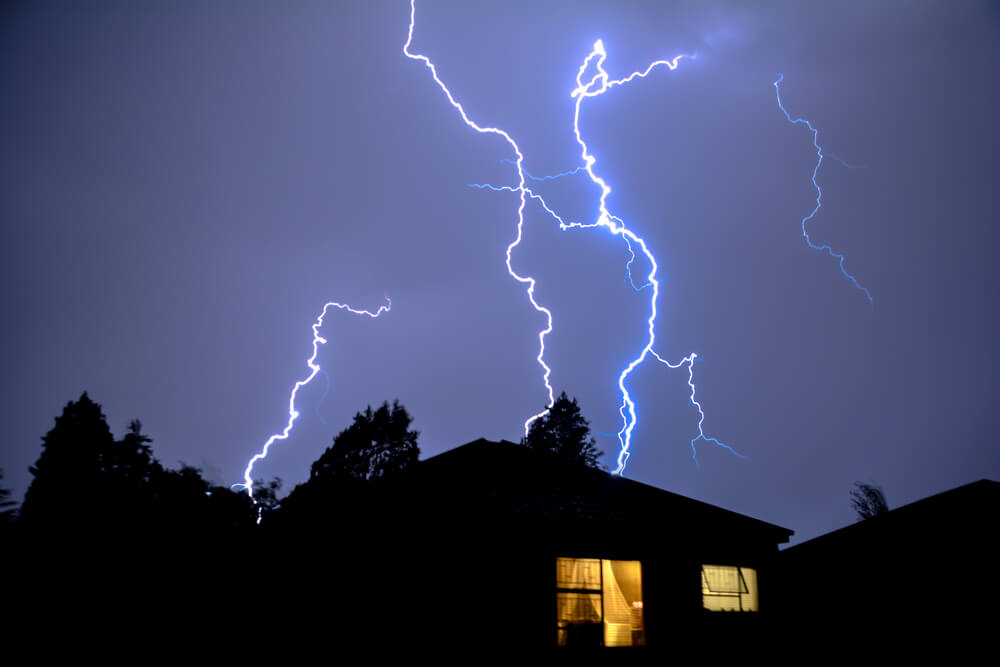Imagine being at home during a thunderstorm with you and your family using electronics like computers and television when ZAP! A nearby lightning strike causes a huge power surge to flow through your home’s electrical system. Your computers, television, HVAC, smart devices, and appliances all have burned-out electronics and will need to be replaced.
A whole-home surge protector could have saved you a whole lot of trouble, time, and money.
Can a Power Surge Damage My Electronics?
An electrical surge is when more voltage is applied to an electrical device than the device or system is designed to handle. Surges overload and short out the circuitry of home electronics and anything else plugged into the wall.
Items can be damaged with both large and small power surges. Large power surges take out electrical devices in one big sweep.
In addition to large power surges, smaller, repeated power surges can cause damage over time. These surges are common in homes. Frayed wires connected to other metal pieces, electronics grabbing for power from the circuit, and temporary cutting off other electrical devices. These small surges are often the culprit behind why your TV or phone mysteriously stops working.
These smaller surges cause incremental damage over time until the electronic components finally erode. Small surges shorten the lifespan of appliances and electronics.
How Do Power Surges Damage My Electronics?
In the United States, power is delivered to properties in the form of 120 volts, 60 hertz, single phase, alternating current. There is a lot to unpack in that sentence, but we’ll just focus on the voltage and alternating current parts.
Volts are not delivered at a constant 120. Instead, the alternating current rises and falls in a rhythmic wave pattern. It oscillates up and down from a low of zero to a peak of 169 volts. The majority of electronics use 120 volts, though some larger devices like dryers and air conditioners use 220 volts.
During a power surge, the voltage goes above 169 volts. This spike in voltage cannot be held by the device, which can create arcs of current within. These arcs generate a lot of concentrated heat, which then burns and damages the electronic components.
What Causes Power Surges?
Several things can cause power surges that will damage your home’s electrical systems:
- Nearby lightning strikes
- Large electrical devices like air conditioners and refrigerators
- Power surges from your electric utility company during a power grid switching
There is a reason that large 220V devices like your dryer and air conditioner are usually placed on a dedicated power circuit, and that is to prevent surges from the device from overloading other devices on the same line.
How to Prevent Power Surges & Protect Your Home
At a minimum, homeowners should use point-of-use surge protection devices (SPDs) combined with a good grounding system to protect the more valuable electronics from electrical surges.
The way that SPDs protect your devices is by sending the extra voltage to the grounding system instead of the devices. You should have SPDs for your computer, television, microwave, and any other device worth more than $100.
Grounding System
The first pitfall many homeowners don’t know about is that not all outlets are reliably grounded. Just because your outlet is a three-pronged outlet does not necessarily mean that it is grounded. A DIYer or amateur electrician may have installed a three-pronged outlet but not bothered or known to run the grounding wire.
If they did run the grounding wire, that doesn’t mean your home grounding system was set up correctly. A quick and easy way to test if your outlets are grounded is with a multimeter. If you are unsure if your home has a good grounding system, it’s best to get an electrical inspection from a certified electrician who can check your system over for problems and building code violations.
Point-of-Use Surge Protection Devices

A point-of-use surge protection device can come in a number of different forms. One of the most common forms homeowners are familiar with is the form of a power strip.
It is important to note that not all power strips are surge protectors, and even those that are are not always created equally. Point-of-use surge protectors provide no lightning protection. They are limited to much milder surges.
How Do I Choose a Point-of-Use Surge Protector?
The new surge protector performance rating is called UL 1449 Voltage Protection Rating (VPR). The VPR measures how much voltage is “let-through,” which is the maximum voltage this surge protector will let through to devices. The lower the VPR number, the better it protects against surges.
Two older rating systems are UL 1449 Suppressed Voltage Rating (SVR) and a Joules rating. SVR is based on a test using a 500-amp current. Again, the lower the rating, the better the protection.
Joules is the amount of energy the surge protector can absorb over time. Manufacturers learned that by increasing the amount of time, the higher the joules they could advertise. Since electrical surges happen very quickly, and consumers quickly realized that joules was a poor rating system. Look for a joule rating of over 600 by a reputable company. A joule rating of 1,000 to 2,000 is better.
The response time is how quickly, in nanoseconds, the surge protector reacts to a surge. The faster the time, the better the protection. One nanosecond or less is best.
Clamping voltage indicates the voltage level at which the surge protector will attenuate (weaken) the surge. A lower clamping voltage is preferred. The best surge protection will not exceed 400 volts.
Do I Really Need a Whole-Home Surge Protector, or Can I Use Surge Protector Power Strips?

Most people realize that it’s important to plug computers into high-voltage surge protectors with backup batteries, but what about the computers in your TV, smart appliances, and other devices like refrigerators and washing machines?
Many new appliances come with their own mini-computers to regulate functions, connect to wifi, and more. Electrical surges can damage these items. Do you have power strips for all your devices and appliances? Are those power strips rated for surge protection? How much voltage are they rated for?
Even if you get point-of-use surge protectors for all your major appliances (which can be harder for the 220V ones), even simple lights and anything else that uses electricity can be damaged in an electrical surge.
The only way to secure the whole house is with a whole-home surge protector. Even with a whole-home protector, we still recommend point-of-use surge protectors for important devices like your computer and television.
The Best Surge Protection Approach: A Two-Tiered Approach
The best way to protect your home from electrical surges is a two-tiered approach: use both a whole-home service entrance surge protector and combine that with point-of-use surge protection devices on your more important devices.
Service entry whole-home surge protectors are installed at the meter or at the main service electrical box. They will protect your entire electrical system, including things that cannot easily have point-of-use surge protection, like your motors, lights, outlets, light switches, and more. Service entry SPDs protect your home from outside surges like nearby lightning strikes and surges from the electrical grid. They provide some, but not full, protection from internal surges (ones that originate from within your home).
Whole-home surge protection devices will be either transient volt surge suppressors or secondary surge arrestors. They will take care of medium and low surges and dampen large surges. Your point-of-use SPDs ground the remaining voltage that makes it through your whole-home surge defense. Point-of-use SPDs are also the final defense for internal surges.
Whole-home electrical panel surge protectors should be viewed as having a limited lifespan if your area has high surge activity and will need to be replaced periodically. If you live in such an area, it’s important to get one that will warn you when it no longer is providing active protection.
Consult a certified electrician for the best type of whole-home surge protection system for your home and area, and for installation.
Call Anthony for a certified electrician to evaluate your home for a whole-home surge protection system in Kansas City and surrounding areas. Our KC electrical experts will ensure that your home is protected from electrical surges.

